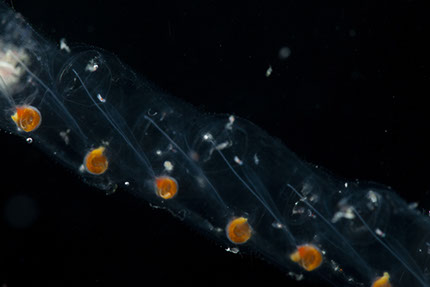Salps

Salps are a type of gelatinous zooplankton. That means that (like jellyfish) they don't have hard parts. Their bodies are mostly water. However, salps are very different from jellyfish. Salps are basically a bag of water with a stomach. They feed primarily on algae and other tiny organisms in the ocean. They are sometimes referred to as the ocean's vacuum cleaner because they filter the water so rapidly in their attempt to capture prey.
Salps range in size from~1-cm to >30-cm in size. They are typically shaped like a barrel. Salps have a mesh filter that they produce near the front of the barrel and they use this mesh to catch their prey. The size of the mesh determines what size of organisms the salps will catch and feed on. Most salps have a very fine mesh that allows them to feed efficiently on some of the smallest plankton in the ocean despite their relatively large size (for a zooplankton). Salps feed by contracting muscle bands that encircle their bodies. When they contract these muscles water is pushed through the salp (and through their filter) and the salp is pushed through the water. Salps cannot eat without swimming at the same time.

Salps also have a very interesting life cycle, known as alternation of generations. Salps have two different life stages: a solitary asexual stage and a colonial sexual stage. The solitary stage of salps (also referred to as the oozooid stage, and shown in the picture on the top right) has a special structure called a stolon. This stolon develops into chains of the colonial stage. When a chain of the aggregate stage has grown large enough within the solitary organism the chain will be released. The chain is the sexual stage of the salp (also referred to as the blastozooid stage and shown in the picture on the right). In many species, the colonial stage (chain) looks very different from the solitary stage, and in fact when scientists first discovered salps they often thought that the colonial and solitary stages of the same species were actually different species. Chains of the colonial stage can extend for several meters in the water, and include hundreds of individuals. The chains start off as females, and are fertilized by the sperm from older chains. Once the eggs within a chain are fertilized, an embryo (of the solitary stage) will grow within each individual of the colonial stage. The colonial stage will then give live birth to the solitary (asexual) stage so that the process can repeat itself. As the chains matures it will switch from a female to a male.
The entire life cycle of a salp can be completed very rapidly. In some species, a solitary individual can release a chain only a little more than a day after it is born and it can release additional chains every four to five hours. Each individual within the chains, can then produce more solitary organisms roughly a day later. This leads to rapid growth of the species and allows salps to bloom rapidly when conditions are favorable. Large blooms of salps can reach huge densities in the ocean - and these huge densities combined with the rapid feeding of salps causes salps to exert a huge grazing pressure on algae when they are abundant. The unique life history of salps, thus causes them to have very patchy distributions in the ocean. They can form huge blooms at times, but are often not abundant at all, which makes them a challenge to study. Nevertheless, they may have a large impact on the global carbon cycle, because they can produce large fecal pellets that sink rapidly and transport carbon from the surface to the bottom of the ocean - leading to substantial net carbon dioxide sequestration.
If you want to learn more about salps, I recommend this radio interview of our colleague Moira Decima: https://www.radionz.co.nz/audio/player?audio_id=2018676118
This portion of our website is specifically designed as outreach to the general public. If you are a scientist look for details about our research, please click on the red 'For Scientists' link on the top right.
Contact: Mike Stukel (mstukel@fsu.edu)
Florida State University
Dept. of Earth, Ocean, and Atmospheric Science
Center for Ocean-Atmospheric Prediction Studies
